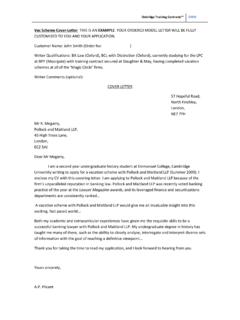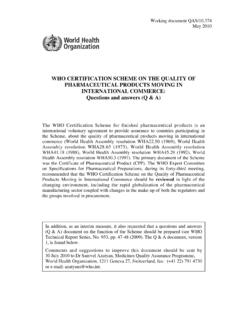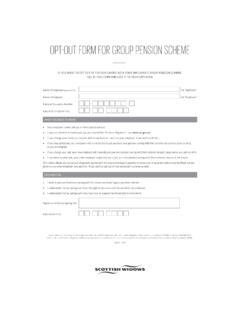Transcription of Mark Scheme for June 2013 - OCR
1 Oxford Cambridge and RSA Examinations GCE Physical Education Advanced GCE Unit G453: Principles and concepts across different areas of Physical Education Mark Scheme for june 2013 OCR (Oxford Cambridge and RSA) is a leading UK awarding body, providing a wide range of qualifications to meet the needs of candidates of all ages and abilities. OCR qualifications include AS/A Levels, Diplomas, GCSEs, Cambridge Nationals, Cambridge Technicals, Functional Skills, Key Skills, Entry Level qualifications, NVQs and vocational qualifications in areas such as IT, business, languages, teaching/training, administration and secretarial skills. It is also responsible for developing new specifications to meet national requirements and the needs of students and teachers. OCR is a not-for-profit organisation; any surplus made is invested back into the establishment to help towards the development of qualifications and support, which keep pace with the changing needs of today s society.
2 This mark Scheme is published as an aid to teachers and students, to indicate the requirements of the examination. It shows the basis on which marks were awarded by examiners. It does not indicate the details of the discussions which took place at an examiners meeting before marking commenced. All examiners are instructed that alternative correct answers and unexpected approaches in candidates scripts must be given marks that fairly reflect the relevant knowledge and skills demonstrated. Mark schemes should be read in conjunction with the published question papers and the report on the examination. OCR will not enter into any discussion or correspondence in connection with this mark Scheme . OCR 2013 G453 Mark Scheme june 2013 1 Annotations Annotation Meaning = Correct response = Not answering the question = Benefit of the doubt = Repeat = Too Vague = Development (levels Scheme ) = Significant amount of material which does not answer the question = Noted but no credit given = Level 1 (levels Scheme ) = Level 2 (levels Scheme ) = Level 3 (levels Scheme ) = Level 4 (levels Scheme ) = Practical example (levels Scheme ) = Evaluative point (levels Scheme ) = Independent opinion (levels Scheme ) G453 Mark Scheme june 2013 2 Subject-specific Marking Instructions Marking responses a c ; points marked questions An element of professional judgement is required in the marking of G453.
3 Correct answers should always be rewarded irrespective of whether or not they appear on the mark Scheme . If you are in doubt about the validity of any answer then consult your Team Leader (Supervisor) by phone or e-mail. Marking response d ; levels of response marked question It is quite possible for an excellent and valid answer to contain knowledge and arguments which do not appear in the indicative content on the mark Scheme . Each answer must be assessed on its own merits according to the generic descriptors and discriminators. The levels of response descriptors are cumulative, ie a description at one level builds on or improves the descriptions at lower levels. Not all qualities listed in a level must be demonstrated in an answer for it to fall in that level. Candidates will take different approaches to achieve within the same level. Some will adopt a less focused approach but demonstrate a wide range of knowledge others may adopt a more focused approach using a narrower range of well-developed knowledge.
4 Approach to marking levels of response questions: read the candidate response in full; working from the top down and using a best-fit approach, refer to the generic descriptors and discriminators to determine the level; re-read the answer, highlighting credit worthy aspects of the response in relation to knowledge, understanding, development, examples, etc; confirm or revise initial decision re level; determine the mark within the level as per the guidance in 10 (above), with reference to the discriminators, and, again, using a best-fit approach. G453 Mark Scheme june 2013 3 Section A Historical Studies (Option A1) Question Answer marks Guidance 1 (a) 5 marks for 5 of: Socio-cultural factors that influenced the characteristics of mob football (sub max 4) Socio-cultural factors Mob football characteristics 1. limited transport and/or communications Local/localised rules 2. illiteracy/no NGBs/uneducated simple unwritten rules or limited organisation/un-codified 3. reflection of life and time/ harsh society/lack of policing violent or dangerous 4.
5 Seasonal time/free time on Holy Days or annual holiday or lack of spare/free time Occasional or festival 5. agricultural/before industrial revolution/before migration to towns/population centred on village or county town life Rural or natural 6. Lack of facilities/equipment or lack of technology or poverty Simple or inexpensive to play 7. Rags to riches/increase income wagering 8. two class society/feudal system played by lower class (males) How one socio-cultural factor continues to Sub max 1 for one of: 9. transport eg not having a car so unable to get to facility 10. education eg encouraged to pursue a healthy active lifestyle which might include playing football 11. reflection of society eg impact of recession limiting finance but possibly giving time due to unemployment 12. time eg working long hours and unable to get to training 13. money/income eg unemployed and unable to afford kit or join club / can play in it simplest form without expense. 14. Technology improved equipment to better performance 5 Sub max 4 for Socio-cultural factors Must have link between factor and characteristic to score each mark.
6 Sub max 1 for how one of these factors continues to impact on participation in football today. Accept any suitable examples. Accept a positive impact as a result increased use of transport enables more fixtures. G453 Mark Scheme june 2013 4 Question Answer marks Guidance (b) 5 marks for 5 of: Description of public schools stage two (sub max 4) 1. (transition) (Transition from ) popular recreation to rational recreation 2. (expansion) School expansion or curriculum expansion/sport and an academic curriculum 3. (overall reform) Time of reform or new moral code / values established or example of values/character building increasingly civilised/more orderly/better behaviour/less barbaric (punishments) 4. (reflection) Reflection of changes in society 5. (Muscular Christianity) Muscular Christianity or godliness and manliness or chapel as centre of school or sporting success glorify God 6. (responsibility) Responsibility given to sixth form or sixth form became link between masters and younger boys or sixth form as police force /older boys as role models/6th form organised games 7.
7 (relationships) Improved relationships or more trust / respect or less bullying / brutality / teachers have pastoral role / more involved 8. (house system) House system developed / expanded or Inter-house games 9. (social control) (Games used to establish) social control or more discipline or kept them busy/occupied 10. (regularity) Games or sports more regular 11. (technical dev/ status) Games or sports more organised / structured / sophisticated or specialist / technical equipment / facilities/ or (some) purpose built facilities 12. (status) Status of games grew or games became central to public school life 5 Sub max 4 for description of stage two G453 Mark Scheme june 2013 5 Question Answer marks Guidance (one reason for slower development of athleticism in girls public schools) Sub max one mark for: 13. (social inferiority) notion of keeping women in their place or the traditional role of women in society or (perceived) lower status of women in society or belief that girls did not need / deserve the same opportunities as boys 14.
8 (physical inferiority) (perceived) physical inferiority of women or belief that physical activity was harmful / dangerous for women/(perception) of danger to pregnancy 15. (unladylike) belief that it was inappropriate / unladylike for women to be athletic / competitive or concern over wearing revealing clothing/socially unacceptable 16. (alternatives) Girls schools concentrated on other things or girls schools concentrated on music / dancing / posture. 17. (role models/ reformers) There were no / fewer women role models or there were fewer leading women reformers/ heads in girls schools (than in boys schools) Sub max 1 for slower development of athleticism in girls public schools G453 Mark Scheme june 2013 6 Question Answer marks Guidance (c) 5 marks for 5 of: The 1902 Model Course was quickly replaced : Sub max of four marks for four from: 1. (military) ..of its militaristic nature or it focused on preparation for war which was considered inappropriate or it was imposed by War Office or it was introduced due to Boer war 2.
9 (guns) ..proficiency with guns no longer necessary / desirable or dummy weapons drill outdated or new era needed / new approach or more enlightened times 3. (NCOs) .. taught by army (NCOs) who didn t understand or cater for children 4. (command like soldiers) ..its command style was no longer (thought to be) appropriate or children were treated like soldiers 5. (centralised) ..of its centralised approach/ everyone did same thing at same time or it had no individuality / creativity / group work 6. (differences) ..it didn t cater for different ages / genders or a more child centred approach was needed 7. (backward step) ..(it was a backward step because it) lowered the status of the subject or the pre-1902 approach was (comparatively) innovative or progressives / supporters of Swedish gymnastics didn t approve of it or a move back to Swedish system wanted 8. (health/ Newman) a more therapeutic approach was needed or Model Course did not consider health or there was concern over children s health or Dr George Newman became involved 9.
10 (boring) ..it was too narrow / boring / dull / repetitive or a more varied or broader approach was needed or lessons were the same each time or athletic / gymnastic / games skills considered valuable 10. (new equipment) ..more / new / varied equipment became available or bean bags / ropes / balls / hoops (or equiv) 11. (Education) ..power given back to Education Dept (rather than the War Office) 5 Sub max 4 for why the 1902 Model Course was quickly replaced. Do not accept a list without explanation G453 Mark Scheme june 2013 7 Question Answer marks Guidance One objective of the 1933 Syllabus that differed from the objectives of the 1902 Model Course. (sub max 1) 12. Objectives of the 1933 Syllabus that differed from 1902 included the development of: Physical fitness Skills Health/therapeutic aims (Good) physique (Good) posture The whole child/mind and body/holistic/create thinkers Treating children as children or not treating children as little soldiers.


















